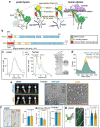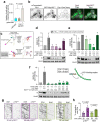Conserved roles for the dynein intermediate chain and Ndel1 in assembly and activation of dynein
- PMID: 37730751
- PMCID: PMC10511499
- DOI: 10.1038/s41467-023-41466-5
Conserved roles for the dynein intermediate chain and Ndel1 in assembly and activation of dynein
Abstract
Processive transport by the microtubule motor cytoplasmic dynein requires the regulated assembly of a dynein-dynactin-adapter complex. Interactions between dynein and dynactin were initially ascribed to the dynein intermediate chain N-terminus and the dynactin subunit p150Glued. However, recent cryo-EM structures have not resolved this interaction, questioning its importance. The intermediate chain also interacts with Nde1/Ndel1, which compete with p150Glued for binding. We reveal that the intermediate chain N-terminus is a critical evolutionarily conserved hub that interacts with dynactin and Ndel1, the latter of which recruits LIS1 to drive complex assembly. In additon to revealing that the intermediate chain N-terminus is likely bound to p150Glued in active transport complexes, our data support a model whereby Ndel1-LIS1 must dissociate prior to LIS1 being handed off to dynein in temporally discrete steps. Our work reveals previously unknown steps in the dynein activation pathway, and provide insight into the integrated activities of LIS1/Ndel1 and dynactin/cargo-adapters.
© 2023. Springer Nature Limited.
Conflict of interest statement
The authors declare no competing interests.
Figures






Update of
-
Conserved Roles for the Dynein Intermediate Chain and Ndel1 in Assembly and Activation of Dynein.bioRxiv [Preprint]. 2023 Jan 14:2023.01.13.523097. doi: 10.1101/2023.01.13.523097. bioRxiv. 2023. Update in: Nat Commun. 2023 Sep 20;14(1):5833. doi: 10.1038/s41467-023-41466-5. PMID: 36711700 Free PMC article. Updated. Preprint.
Similar articles
-
Conserved Roles for the Dynein Intermediate Chain and Ndel1 in Assembly and Activation of Dynein.bioRxiv [Preprint]. 2023 Jan 14:2023.01.13.523097. doi: 10.1101/2023.01.13.523097. bioRxiv. 2023. Update in: Nat Commun. 2023 Sep 20;14(1):5833. doi: 10.1038/s41467-023-41466-5. PMID: 36711700 Free PMC article. Updated. Preprint.
-
Nde1 promotes Lis1-mediated activation of dynein.Nat Commun. 2023 Nov 9;14(1):7221. doi: 10.1038/s41467-023-42907-x. Nat Commun. 2023. PMID: 37940657 Free PMC article.
-
Multivalency, autoinhibition, and protein disorder in the regulation of interactions of dynein intermediate chain with dynactin and the nuclear distribution protein.Elife. 2022 Nov 23;11:e80217. doi: 10.7554/eLife.80217. Elife. 2022. PMID: 36416224 Free PMC article.
-
Nde1 and Ndel1: Outstanding Mysteries in Dynein-Mediated Transport.Front Cell Dev Biol. 2022 Apr 12;10:871935. doi: 10.3389/fcell.2022.871935. eCollection 2022. Front Cell Dev Biol. 2022. PMID: 35493069 Free PMC article. Review.
-
Activation and Regulation of Cytoplasmic Dynein.Trends Biochem Sci. 2020 May;45(5):440-453. doi: 10.1016/j.tibs.2020.02.002. Epub 2020 Mar 5. Trends Biochem Sci. 2020. PMID: 32311337 Free PMC article. Review.
Cited by
-
Molecular basis for the assembly of the dynein transport machinery on microtubules.bioRxiv [Preprint]. 2024 Dec 30:2024.12.30.630772. doi: 10.1101/2024.12.30.630772. bioRxiv. 2024. PMID: 39803430 Free PMC article. Preprint.
-
Cargo adaptor identity controls the mechanism and kinetics of dynein activation.bioRxiv [Preprint]. 2024 Oct 12:2024.10.09.617440. doi: 10.1101/2024.10.09.617440. bioRxiv. 2024. Update in: J Biol Chem. 2025 Apr;301(4):108358. doi: 10.1016/j.jbc.2025.108358. PMID: 39416085 Free PMC article. Updated. Preprint.
-
VezA/vezatin facilitates proper assembly of the dynactin complex in vivo.Cell Rep. 2024 Nov 26;43(11):114943. doi: 10.1016/j.celrep.2024.114943. Epub 2024 Nov 1. Cell Rep. 2024. PMID: 39487986 Free PMC article.
-
The mechanochemical cycle of reactive full-length human dynein 1.Nat Struct Mol Biol. 2025 Aug;32(8):1383-1395. doi: 10.1038/s41594-025-01543-3. Epub 2025 Apr 22. Nat Struct Mol Biol. 2025. PMID: 40263469 Free PMC article.
-
Ndel1 disfavors dynein-dynactin-adaptor complex formation in two distinct ways.J Biol Chem. 2023 Jun;299(6):104735. doi: 10.1016/j.jbc.2023.104735. Epub 2023 Apr 21. J Biol Chem. 2023. PMID: 37086789 Free PMC article.
References
-
- Willemsen MH, et al. Mutations in DYNC1H1 cause severe intellectual disability with neuronal migration defects. J. Med. Genet. 2012;49:179–183. - PubMed
Publication types
MeSH terms
Substances
Grants and funding
LinkOut - more resources
Full Text Sources
Miscellaneous

